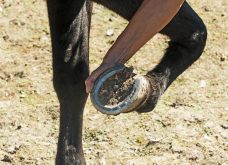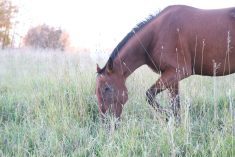Phenylbutazone, referred to as “bute” amongst horsemen, is a non-steroidal anti-inflammatory drug used for the short-term relief of pain, inflammation, and fever in horses. It is one of the most common medications administered to horses but indiscriminate use is wrought with adverse consequences. Therefore horse owners must be aware of its appropriate and prudent use.
Phenylbutazone is indicated for the treatment of a wide variety of musculoskeletal ailments. These can include but are not limited to acute sprains, strains, injuries, muscular overuse, tendonitis, degenerative joint diseases, navicular syndrome, laminitis, and arthritis. The hallmark of these ailments is pain and inflammation.
Read Also

Pig transport stress costs pork sector
Popular livestock trailer designs also increase pig stress during transportation, hitting at meat quality, animal welfare and farm profit, Agriculture and Agri-Food Canada researcher says
Since phenylbutazone can alleviate pain in horses it may be used inappropriately to mask lameness for competition, work or sale purposes. As such regulations regarding its use varies within disciplines and their governing bodies.
Phenylbutazone is frequently the first drug of choice for pain control and inflammation because it is relatively inexpensive and effective. It is carried under many brand labels and is available in tablet or paste formulation for oral administration, or as an injectable product strictly for intravenous use. It is not given intramuscularly as it is extremely irritating to the tissues.
Risky practice
Despite the manufacturer’s recommendations that phenyl-butazone be administered under veterinary supervision, many horse owners administer their own “bute.” Non-steroidal anti-inflammatory drugs (NSAID) such as phenylbutazone affect the body by blocking the cascade of chemicals that produce prostaglandins, which are responsible for symptoms of pain and inflammation. Prostaglandins are also responsible for maintaining blood flow to vital tissues such as the lining of the stomach, intestinal tract and kidneys.
As a result phenylbutazone’s mechanism of action in the body places vital tissues at risk, potentially damaging the lining of the gastrointestinal tract and compromising blood flow to the kidneys. Clinical signs of phenylbutazone toxicity include loss of appetite, depression, teeth grinding, mild colic, weight loss, renal failure, and edema under the belly and in the legs. Hemorrhages and ulcers often occur in the mouth, esophagus, stomach, cecum and right dorsal colon.
Phenylbutazone’s injurious and lethal toxicities often come as a complete surprise to owners due to ignorance, careless dosing, or failing to recognize factors that increase the likelihood of adverse effects.
Certain populations of horses such as foals, ponies, older horses and debilitated or dehydrated horses carry a higher risk for harm. Horses that are dehydrated are particularly susceptible to phenylbutazone toxicity, since blood flow to the kidneys is already compromised.
A phenomena known as “stacking” has become an increasingly common practice whereby non-steroidal anti-inflammatory drugs and/or medications are combined in hopes of further reducing pain and inflammation. These practices greatly increase the potential of adverse side-effects.
Document required
The indiscriminate use of phenylbutazone in horses whether obtained through or outside the prescription system will continue to come under increasing scrutiny. As of July 31, 2010 all horses slaughtered for human consumption in Canada must arrive at the slaughterhouse with an Equine Information Document. The EID identifies the horse and a record of medications administered to that horse over the previous six months. Horses that have received phenylbutazone are not eligible for slaughter as phenylbutazone has been found to be linked to bone marrow toxicity in humans. The Canadian Food Inspection Agency has zero tolerance for phenylbutazone in food. Horse owners may expect increasing vigilance and prudence by veterinary practitioners whom prescribe phenylbutazone.
Medications that relieve pain and inflammation without heeding and acknowledging the experience that created the pain and inflammation can be counterproductive, even harmful to the long-term well-being of the horse.
Pain is an intelligent form of communication from the body. Inflammation and pain when allowed their course are a part of the natural healing process. As a messenger, pain brings information. An understanding of pain leads to clear decision-making and management in the health and welfare of the horse. Then and only then is pain relief truly effective and compassionate.



















